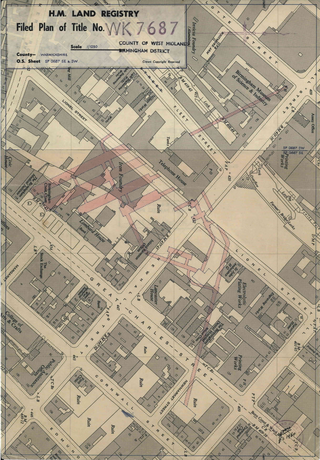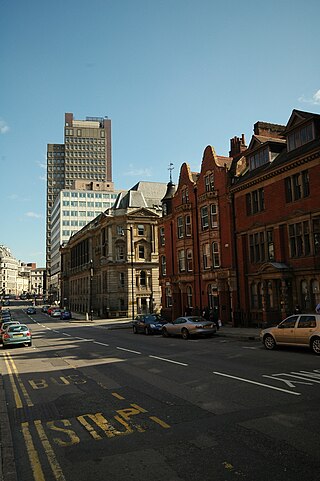
Matthew Boulton was an English businessman, inventor, mechanical engineer, and silversmith. He was a business partner of the Scottish engineer James Watt. In the final quarter of the 18th century, the partnership installed hundreds of Boulton & Watt steam engines, which were a great advance on the state of the art, making possible the mechanisation of factories and mills. Boulton applied modern techniques to the minting of coins, striking millions of pieces for Britain and other countries, and supplying the Royal Mint with up-to-date equipment.

Anchor Exchange is an underground telephone switching system and former hardened telephone exchange built in Birmingham, England.
A hallmark is an official mark or series of marks struck on items made of metal, mostly to certify the content of noble metals—such as platinum, gold, silver and in some nations, palladium. In a more general sense, the term hallmark is used to refer to any standard of quality. Not to be confused with responsibility marks that are the marks of the maker.

The Sheffield Assay Office is one of the four remaining assay offices in the United Kingdom, the other three being in London, Birmingham, and Edinburgh.
Assay offices are institutions set up to assay precious metals. This is often done to protect consumers from buying fake items. Upon successful completion of an assay the assay offices typically stamp a hallmark on the item to certify its metallurgical content. Hallmarking first appeared in France, with the Goldsmiths' Statute of 1260 promulgated under Étienne Boileau, Provost of Paris, for King Louis IX.

The Jewellery Quarter is an area of central Birmingham, England, in the north-western area of Birmingham City Centre, with a population of 19,000 in a 1.07-square-kilometre (264-acre) area.
This article shows the development timeline of telephone companies in Birmingham, England.

Newhall Street is a street located in Birmingham, England.

The Elkington Silver Electroplating Works was a building on Newhall Street in Birmingham, England. It later housed the Birmingham science museum Museum of Science and Industry until the creation of Thinktank.

Garrard & Co. Limited designs and manufactures luxury jewellery and silver. George Wickes founded Garrard in London in 1735 and the brand is headquartered at Albemarle Street in Mayfair, London. Garrard also has a presence in a number of other locations globally. Garrard was the first official and most notably important Crown Jeweller of the United Kingdom having supplied jewels for Queen Victoria, and was charged with the upkeep of the British Crown Jewels, from 1843 to 2007, and was responsible for the creation of many tiaras and jewels still worn by the British royal family today. As well as jewellery, Garrard is known for having created some of the world's most illustrious sporting trophies, including the America's Cup, the ICC Cricket World Cup Trophy and a number of trophies for Royal Ascot in its role as Official Trophies and Silverware Supplier, which originally dates back to the first Gold Cup in 1842.

Birmingham city centre, also known as Central Birmingham, is the central business district of Birmingham, England. The area was historically in Warwickshire. Following the removal of the Inner Ring Road, the city centre is now defined as being the area within the Middle Ring Road. The city centre is undergoing massive redevelopment with the Big City Plan, which means there are now nine emerging districts and the city centre is approximately five times bigger.

A silver object that is to be sold commercially is, in most countries, stamped with one or more silver hallmarks indicating the purity of the silver, the mark of the manufacturer or silversmith, and other (optional) markings to indicate the date of manufacture and additional information about the piece. In some countries, a national assayer's office controls the testing of silver objects and marking of purity.

Mappin & Webb is an international jewellery company headquartered in England, tracing its origins to a silver workshop founded in Sheffield in 1775. It now has retail stores throughout the UK.
Hersey & Son is a company founded in Clerkenwell, England. The company is a noted firm of Silversmiths with a history dating back to 1955 when Michael Hersey started his apprenticeship and to 1971 when he and David Mills founded the firm.
The Goldsmiths' Company Assay Office in London is the oldest assay office in the United Kingdom. The company has provided hallmarking services since The Goldsmiths Company was founded in the 14th century. The company received its royal charter in 1327 and ranks fifth in order of precedence of the 12 great livery companies of the City of London.

George Unite was an English silversmith working in Birmingham, England.
Thomas Fattorini Ltd is a manufacturing jeweller and designer-maker of awards, trophies, ceremonial swords, civic insignia, medals and name badges. The company is located on three sites in Manchester, Birmingham and London with their head office in Skipton, North Yorkshire.

Daniel Christian Fueter (1720–1785), whose name was variously written as Fouaitier and Fouetter, was a Swiss-American silversmith and medalist, active in New York City from about 1754 until 1764 or 1766.
Stanley George Morris was a British silversmith. His work was part of the painting event in the art competition at the 1948 Summer Olympics.
Joyce Rosemary Himsworth was a British independent designer silversmith. From an early age she worked with her father, the polymath Joseph Beeston Himsworth (1874–1968) making small spoons and items of jewellery. She went on to study at Sheffield College of Arts and Craft, focusing on jewellery manufacture and enamelling. Her undoubted talents were not enough for her to gain a position within the family cutlery firm, B. Worth & Sons.


















